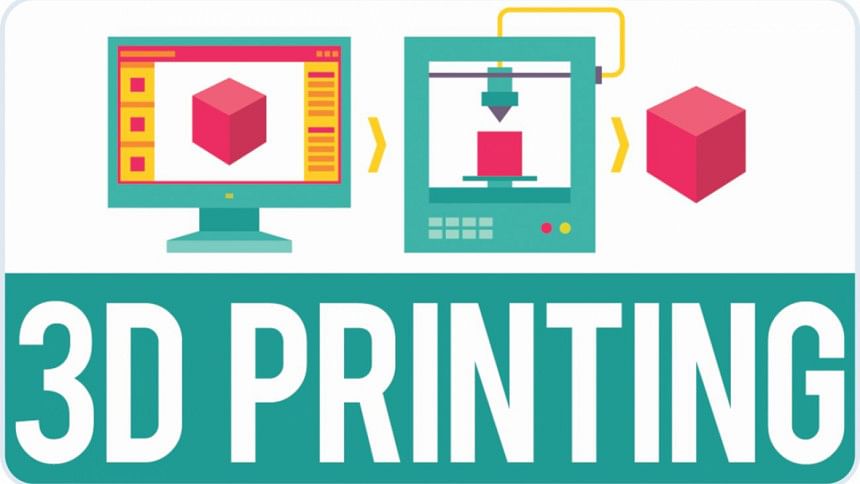Legal issues in 3D printing

Watching three-dimensional (3D) movies in sophisticated screen wearing a pair of gorgeous glass is a recent trend. Though the figure and letter '3D' is known to us primarily for this purpose, the developed countries see huge prospects attaching these figure and letter with a printer or scanner i.e. 3D printer or scanner. A 3D printer or scanner enables the owner to design, copy and manufacture any product of his will. World renowned weekly, the Economist considers disruptive technology as the 'Third Industrial Revolution', whereas to the World Economic Forum (WEF) it is the harbinger of 'Fourth Industrial Revolution', as it will have similar impact like ICT or internet.
The prospect of 3D printing or additive manufacturing (AM) or rapid prototyping has been documented in literature for years and consumers started to get the benefits for the last couple of years. Very recently, Chinese company ZhuoDa has exhibited the building of a two-story villa capable to withstand a magnitude 9-earthquake in less than three hours by using six 3D-printed structures assembled like LEGO blocks. Dubai government has started to use an entire office building, including the furniture and interior inside the Emirates Towers complex using 3D printers. The first ever 3D printed car is about to enter the market. Besides, the entrepreneurs from around the world have been exhibiting 3D printed medical devices, human organs etc.
Based on the popular theory of economics, i.e. 'economies of scale', the manufacturers receive cost advantages due to the factors like size, output or scale of operation, etc. These factors help them to offer products in a cheap rate i.e. more production will decrease the production cost leading to price of the goods. On the other hand, manufacturing of small quantity of goods will increase the price. In such context, this 3D printing technology has introduced a new concept of manufacturing as any kind of products can theoretically be developed. Instead of traditional basing, bending or cutting materials, 3D printers make things by depositing materials layer by layer.
3D printers and scanners enable to make three dimensional solid objects from a digital file. Initially, a computer design is developed in a Computer Aided Design (CAD) file either by a 3D modeling program (for making new object) or by using a 3D scanner (for copying existing object). Then the model of the object is sliced into hundreds or thousands of layers, which ultimately enable to create the object layer by layer. To make it easier, a similar technique is used in this technology the way we use our computer to draw or scanner to scan anything and then to print it out.
The WEF revealed that the 3D printing technology can change the world in ten ways. It can- (a) enable the blind and visually impaired people the chance to see, (b) create body plants e.g. bone implants to limbs, (c) produce lightweight casts for broken bones, (d) ensure faster medical progress, (e) make stronger and safer vehicles, (f) ensure better and cleaner factories by reducing the number of factory workers and waste produced by the industry, (g) ensure faster design and innovation, (h) promise less pollution from shipping, (i) guarantee better education in science, technology, engineering and mathematics as using printers the schools can make subjects more engaging, and (j) enable to make miniaturized devices to guarantee targeted medical treatment.
As a new technology, it has already raised many legal concerns. Implementation of laws of patent, copyright and design will be important initially as design of any existing product can be copied and made immediately, which may cause loss of at least $100 billion per year globally. Thus, if the 3D printing technology remains unregulated, the basic purpose of intellectual property rights i.e. to foster an environment to flourish the creativity and innovation will have to be compromised.
Rampant availability of 3D printers and scanners in the market will threat citizen's right to life, privacy and security. Availability of fake and counterfeit productsin the market will be very normal. The impacts of these products on human health and environment after the end-use disposal will be another concern. It will be challenging to establish liabilities of 3D printed products. The government is going to lose tax and revenue as people will make their own products.
The serious issue of concern is that 3D printed guns and firearms, which are as effective as the industry manufactured counterparts are already detected in different developed countries as these 3D printed guns are unregulated. This compelled those governments to tighten legislation to introduce 3D printed gun.
The policymakers of developing country like Bangladesh should consider this issue seriously to regulate human actions and needs to take initiative to develop competence on this area. Licensing system for industrial manufacturers should be introduced immediately. The Customs department should be vigilant before permitting the import of 3D printers and scanner, etc. As anyone can collect or download the blueprint of 3D printed object and bring it to the manufactures to develop the object, the manufacturer should ensure that they do not infringe the patent, copyright or design right of other people. They need to remind the customer in clearly terms that the 3D printed product liability will be on the customer.
The writer is a Senior Lecturer at the Faculty of Law, University of Malaya, Malaysia.

 For all latest news, follow The Daily Star's Google News channel.
For all latest news, follow The Daily Star's Google News channel. 



Comments